In a previous article I explained in detail what ISO does in the camera and what, in general, is the best ISO value to use for astrophotography.
It all comes down to finding the ISO value that is the best mix of read noise and dynamic range. Some might wonder about unity gain as well, but you can read here why you shouldn’t worry about unity gain.
Basically it comes down to finding the ISO value from which the upstream read noise will swamp the downstream read noise. Any ISO value beyond this one has no additional benefit and only decreases Dynamic Range. Remember; ISO does not increase the sensitivity of the camera, increasing it doesn’t capture more light while decreasing dynamic range will hurt our images for instance in star color.
I stated that you can go to sensorgen.info and look at the read noise chart for your camera. These charts are not always really clear and there is a better way to show which ISO value you want to use; graph the dynamic range versus the ISO values (on logarithmic scale).
You can check the graph and look for the point in the curve where the linear trend starts. This indicates the point at which the upstream noise swamps the downstream noise and all we do is amplify the signal and the noise, hurting our dynamic range. These are the noise values where we call a sensor ‘ISO-less’. A lot of Nikon cameras are basically ISOless and therefor will show a linear graph right from the first ISO values.
You can find the list for Canon and Sony models here:
Suggested ISO values for Canon
Suggest ISO values for Sony
Suggested ISO values
I want to emphasise that the listed ISO values is the suggested value based on the available Sensorgen data. You should always check this data for your specific model and test it to see if it is right. For some models it might be less clear what the right value is than for others. Furthermore it is possible that there are differences per camera of the same model. You should take this value as a starting point for your own test.
Furthermore it is important to note that there is no benefit in increasing ISO higher than the suggested ISOs, however in some cases you might want to use a lower ISO value for even more Dynamic Range. This could be the case for instance when you expose long enough and the read noise is swamped by the background shot noise and you get the histogram to 1/3 from the right.
Please let me know in the comments below if you think a suggested ISO value is incorrect!
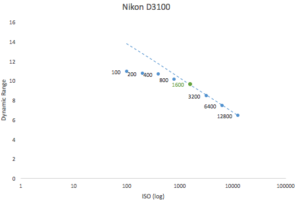

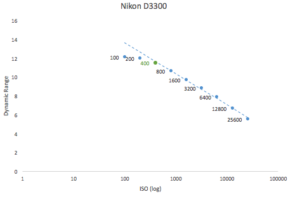
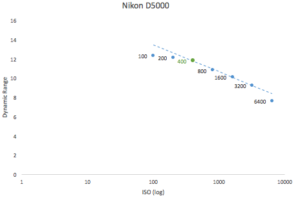
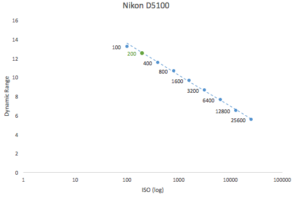


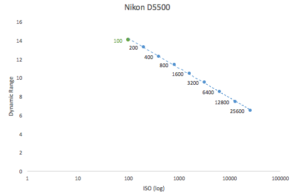

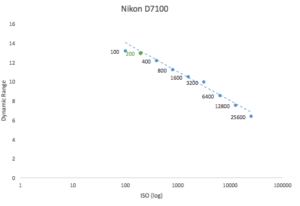

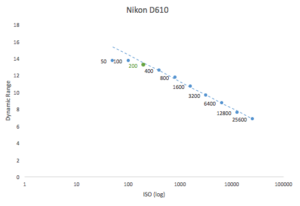

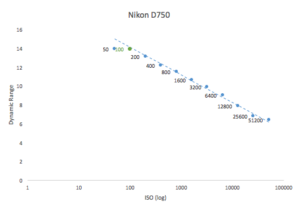
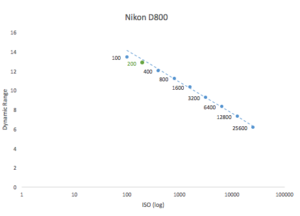
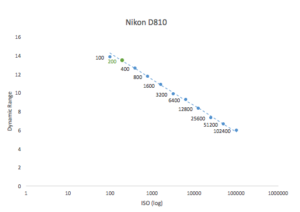

D3200 is definitely off. I’ve read a ton of forum posts, and the consensus is to keep it at iso800. its a hard graph to read for d3200, being straight throughout. But I have yet to see a single person at ISO100 with their d3200.
Thanks for the comment. I’ll look into it in detail to see what’s going on there. The data/graph seems to indicate ISO100, so there must be some specific reason if this is not right.
Do you have any specific link for tests with the d3200 to give me a head start?
Update: Seems to me the ISO 100 is correct for the D3200
All I can say is that I remember seeing an astro forum 50 pages long dealing specifically with D3200. Lots of different analysis, and tests, and the consensus was iso800.
Some say Sensorgen (DXO) data has errors in it, Bill Claff has similar data he produces using photonstophotos.net/Charts/PDR.htm and there his data points to iso200 more.
But in the end, the main problem is that most Nikons correct raw data, so blacks are not true 0, and its hard to compute standard deviation.
It might be because it is close to unity gain and under sampling theoretically could mean less sensitivity for the faintest of signals (those where you only get a few photons per exposure). But I think in reality this is well compensated by the increase in noise and decrease in DR. However, I’m still researching to see if I can give that a definitive answer 🙂
yes, both graphs suggest a lower iso than 800. Also, it is known than Nikons prefer lower ISOs to begin with, so I’m not doubting, just looking for answers my self! thanks for the blog!
Interesting read. A curiosity, D5100 and D7000 have the same sensor. How do you explain the difference? Better FEE fore the D7000 or the so-called black point clipping of the D5100?
Good observation!
2 things are worth noting in my opinion:
first of all, I suspect these differences are probably within the margin of error of the measurements. ISO100 is the one giving the biggest difference in value between the two.
secondly; I don’t know if having the same sensor also means all electronics would be the same. So it could also be a difference in ‘implementation’ of the sensor.
Looking at the data though I think it’s most likely just margin of error of the measurements
What’s the verdict on the Nikon D7500?
There is no data on dxomark (and sensorgen) for the D7500 yet, but as far as I know it has the same sensor as the D500. Judging from the DR data for the D500 I’d say you’re best bet is to try ISO800
Hello,
What about d7200?
regards
what’s the max iso to not go over for nikon d3400??
No way could I get a good exposure for astro at ISO100 on my D750. After experimentation with a 28mm @ F3.5 ISO 1600 and around 17s gave the best workable images.
Did you try stretching it on your computer? This should definitely give you a better result than using ISO1600
Please also read my posting here in which I explained why this is the case;
http://dslr-astrophotography.com/iso-dslr-astrophotography/
ISO100 on a Nikon D750? How are you supposed to capture anything with that? Maybe using a star tracker with extra long exposures? And what do you mean by stretching? I heard that term used by a buy on youtube (Astrobackyard), is this software specific? What do you gain by this “stretching”? Cheers!
Stretching generally means to slowly and carefully increase the exposure by “stretching” the histogram to the right. It can also mean using curves to increase contrast by stretching the difference between highlights, midtones, and shadows.
Right, thanks for clarifying.
Apparently, the term “stretching” is used a lot with PixInsight as well. When you open your master light image in PixInsight and then go to Process > IntensityTransformations > ScreenTransferFunction and click on the yellow atomic symbol. This will auto-stretch your image on the screen, but without actually modifying your data. You now can “see” your data in linear form. This process of being able to “stretch” your image on the screen without altering the actual image is commonly referred to as “screen stretch” or, in PixInsight-speak, STF (for ScreenTransferFunction).
Stretching is ubiquitous in astrophotography. Are you replying in regards to astrophotography or something else?
So if I am understanding this correctly, you should be able to get better results by stacking multiple shots with the recommended ISO, and then stretching more in the computer to bring up the signal, than by using a higher ISO to start with causing a reduced dynamic range. I’m using a D5600 (basically the same as the D5500) and have used ISO 3200 so far for untracked MilkyWay shoots (multiple 10sec f/3.5 exposures then stacked for noise reduction). Suggestions to improve ???
Stacking multiple shots or shooting only one photo doesn’t matter on the ISO you should use. You can stretch a single shot as well and you’ll be better off doing that using your computer rather than using such an high ISO.
Next to that, stacking will always help and be better than a single shot of course
What about Nikon Z6 with it’s dual gain sensor? ISO 100 or 800?
hi, did you check photonstophotos website ?
I have two Nikon DSLRs, a D7500 and a modified D5500. I have tried a range of ISOs. This article is incorrect and the author does not understand how native ISO works or how signal to noise ratio works particularly when stacking many frames. If I followed his idea I would never image any galaxies when using these cameras on my 90mm triplet refractor.
Thanks for your comment. Curious to hear what you tried and how you analysed the results.
I hope you did read the full article explaining the best ISO for astrophotography here; http://dslr-astrophotography.com/iso-dslr-astrophotography/
In another article I addressed unity gain; http://dslr-astrophotography.com/worry-unity-gain/
hope this helps
Gavin Logan: can we see your astrophotography anywhere online? What ISO settings do you prefer to what the author is suggesting in the article?
Perhaps making such a strong claim as: “This article is incorrect and the author does not understand how native ISO works” should be accompanied with evidence otherwise.
Hi,
I have a D5500 and based on this article I’ve been trying to use low ISO values but I get unstackable photos. At 1st I thought the problem was that with my simple mount I couldn’t get high enough exposures but I recently bought a goto mount that lets me use way longer exposures and still I get photos where the stacking software almost can’t discern any stars. I’m going to try with ISO800.
Hi Chris, I am really confused about something.
So, if I take a night image with a Nikon @100iso for one minute, and compare it to a Canon @1600iso for one minute, which one will have more stars? What about noise?
It seems to me that a 1600iso photo will have many, many more stars. If there is more noise, I can use NR in post-processing. So, it seems to me the Canon will “record” more stars and will therefore be more useful as an astrophotography camera. However, this goes against reviews saying the Nikon is the better astrophotography camera.
Where is my thinking wrong?
Thanks!
Hi Dan,
Good question, as this is exactly what is so counter intuitive and why many people struggle with this information.
The thing you always should consider is the stretching (amplifying) done in camera, and depending on the camera characteristics you pick an ISO that is suitable for that camera and stretch the image on your computer later.
The only thing you should remember always is the fact that the ISO is not causing more or less photons to fall on the sensor. In that sense you should view your camera as buckets standing in the rain. Only the time in the rain and the size and number of the buckets will influence how much water you’ll capture. Same goes for capturing photons. All the rest is just amplification and you’ll amplify noise along with it.
I hope this helps.